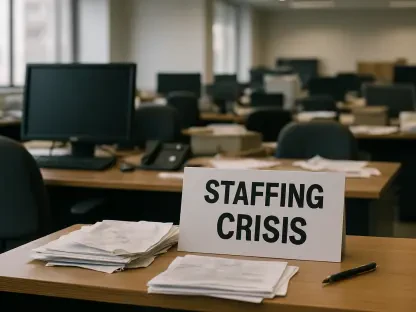In a heartbreaking incident that unfolded in Darwen, Lancashire, a 64-year-old worker lost his life after a mere six-foot fall from a scaffolding tower while installing a metal sign on a shopfront, exposing glaring deficiencies in workplace safety protocols. This tragedy not only shattered a family but also led to significant legal repercussions for the responsible company and its director. The case serves as a stark reminder of how even seemingly minor oversights in safety measures can result in catastrophic outcomes. With work at height remaining one of the leading causes of workplace fatalities in the UK, the incident highlights the urgent need for stringent adherence to safety standards. Beyond the legal penalties, the emotional toll on the victim’s loved ones underscores the human cost of negligence, prompting a broader discussion on accountability and prevention in hazardous work environments.
Unpacking the Tragic Incident
Circumstances of the Fatal Fall
The devastating event occurred on a seemingly routine day when Mr. Iftikhar Ahmed Mughal, an experienced employee, was tasked with installing a sign on a shopfront. Standing on a scaffolding tower platform devoid of any edge protection, he lost his footing and fell just six feet to the pavement below. Despite the relatively low height, the impact resulted in severe head injuries that proved fatal within days. Investigations by the Health and Safety Executive (HSE) revealed a critical lapse in safety measures, as the absence of guardrails—standard and widely recommended for such structures—was a glaring oversight. This incident underscores how even small distances can pose lethal risks when proper precautions are ignored. The tragedy could have been averted with basic safety equipment, highlighting the dire consequences of neglecting established guidelines for working at height.
Personal Impact on the Family
Beyond the physical loss, the emotional devastation felt by Mr. Mughal’s family adds a profound dimension to this tragedy. His son spoke of his father as the pillar of their household, a source of strength and guidance whose absence left them grappling with isolation and grief. The personal toll of such incidents extends far beyond the workplace, affecting loved ones who must navigate life without a cherished family member. This human element emphasizes that workplace safety failures are not merely legal or financial issues but deeply personal tragedies that ripple through entire communities. The pain expressed by the family serves as a poignant reminder of the stakes involved in ensuring safe working conditions, pushing regulators and employers alike to prioritize protective measures over convenience or cost-cutting.
Legal and Regulatory Consequences
Penalties Imposed on the Company and Director
Following an exhaustive investigation, the company employing Mr. Mughal, along with its director, faced severe legal consequences for their negligence. The company admitted to breaching key sections of the Health and Safety at Work Act, resulting in a substantial fine of £45,000 and additional costs. Similarly, the director, who was present during the incident, pleaded guilty to related charges, receiving a suspended custodial sentence of 26 weeks and comparable financial penalties. These outcomes reflect the judiciary’s recognition of the gravity of failing to protect workers from preventable risks. The penalties serve not only as punishment but also as a deterrent to other employers who might overlook safety protocols, reinforcing the principle that accountability is non-negotiable in ensuring workplace safety.
Broader Implications for Workplace Safety
The legal repercussions of this case resonate beyond the individuals involved, shedding light on systemic issues in workplace safety across industries. HSE inspectors noted that falls from height continue to be a leading cause of workplace injuries and deaths, with even low-height falls proving deadly, as seen in this instance. The incident exemplifies how adherence to long-established safety measures, such as installing edge protection on scaffolding, is critical to preventing such tragedies. It also highlights the role of regulatory bodies like the HSE in enforcing compliance and providing accessible guidance to employers. This case serves as a call to action for businesses to re-evaluate their safety practices, ensuring that protective measures are not just implemented but consistently maintained to safeguard workers from avoidable harm.
Reflections on Safety Standards
Lessons Learned from a Preventable Tragedy
Reflecting on this tragic event, it becomes evident that the loss of life was entirely preventable had basic safety standards been followed. The absence of guardrails on the scaffolding tower stood out as a fundamental failure, one that could have been easily rectified with minimal effort or cost. HSE guidelines, widely available and well-known in the industry, explicitly recommend such protective measures to mitigate the risks associated with working at height. This incident exposed a dangerous complacency in adhering to these standards, revealing the need for greater awareness and stricter enforcement. Employers must internalize that cutting corners on safety not only jeopardizes lives but also invites severe legal and reputational consequences, making proactive compliance an ethical and practical imperative.
Moving Forward with Enhanced Protections
In the aftermath of this incident, there has been a renewed focus on strengthening workplace safety protocols to prevent similar occurrences. Regulatory bodies and industry leaders advocated for more rigorous training programs to educate workers and employers on the importance of safety equipment like edge protection. Companies were urged to conduct regular safety audits and invest in proper infrastructure to eliminate risks associated with working at height. Additionally, fostering a culture of accountability ensures that directors and managers prioritize employee well-being over operational shortcuts. The tragedy served as a catalyst for change, encouraging a collective effort to uphold safety as a non-negotiable value, ensuring that no family endures such preventable loss in the future.









